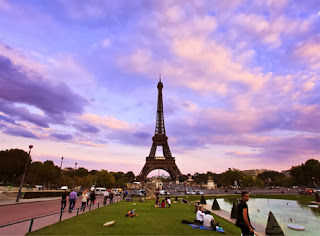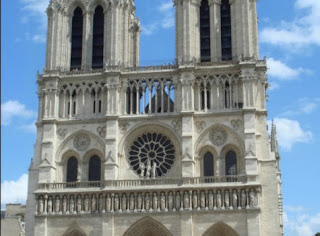Westminster Quarters
The Westminster Quarters is the most common name for a melody used by a set of clock bells to chime on each quarter hour. The number of chime sets matches the number of quarter hours that have passed. It is also known as the Westminster Chimes, or the Cambridge Chimes from its place of origin, the church of St Mary the Great, Cambridge.
This chime is traditionally, though without substantiation, believed to be a set of variations on the four notes that make up the fifth and sixth measures of "I know that my Redeemer liveth" from Handel's Messiah.’This is why the chime is also played by the bells of the so-called 'Red Tower' in Halle, the native town of Handel. It was written in 1793 for a new clock in St Mary the Great, the University Church in Cambridge. There is some doubt over exactly who composed it: Revd Dr Joseph Jowett, Regius Professor of Civil Law, was given the job, but he was probably assisted by either Dr John Randall (1715–99), who was the Professor of Music from 1755, or his brilliant undergraduate pupil, William Crotch (1775-1847).
In the mid-19th century the chime was adopted by the clock tower at the Palace of Westminster (where Big Ben hangs), whence its fame spread. It is now possibly the most commonly used chime for striking clocks.
According to the church records of Trinity Episcopal Church (Williamsport, Pennsylvania), this chime sequence was incorporated into a tower clock mechanism by the E. Howard & Co., Boston, MA. The clock and chime in Trinity's steeple base was dedicated in December 1875. It holds the distinction of being the first tower clock in the United States to sound the Cambridge Quarters.
London Bridge
London Bridge refers to several historical bridges that have spanned the River Thames between the City of London and Southwark, in central London. The current crossing, which opened to traffic in 1973, is a box girder bridge built from concrete and steel. This replaced a 19th-century stone-arched bridge, which in turn superseded a 600-year-old medieval structure. This was preceded by a succession of timber bridges, the first built by the Roman founders of London.
The current bridge stands at the western end of the Pool of London but is positioned 30 metres (98 ft) upstream from previous alignments. The traditional ends of the medieval bridge were marked by St Magnus-the-Martyr on the northern bank and Southwark Cathedral on the southern shore. Until Putney Bridge opened in 1729, London Bridge was the only road-crossing of the Thames downstream of Kingston-upon-Thames.
The modern bridge is owned and maintained by Bridge House Estates, an independent charity overseen by the City of London Corporation. It carries the A3 road, which is maintained by the Greater London Authority. The crossing also delineates an area along the southern bank of the River Thames, between London Bridge and Tower Bridge, that has been designated as a business improvement district.
London Eye
The London Eye is a giant Ferris wheel on the South Bank of the River Thames in London, England. Also known as the Millennium Wheel, its official name was originally the British Airways London Eye, then the Merlin Entertainments London Eye, and since 20 January 2011,[citation needed] the EDF Energy London Eye following a three-year sponsorship deal.The entire structure is 135 metres (443 ft) tall and the wheel has a diameter of 120 metres (394 ft). It is currently Europe's tallest Ferris wheel, the most popular paid tourist attraction in the United Kingdom with over 3.5 million visitors annually, and has made many appearances in popular culture.
When erected in 1999 it was the world's tallest Ferris wheel, until surpassed first by the 160 m (520 ft) Star of Nanchang in 2006 and then the 165 m (541 ft) Singapore Flyer in 2008. Supported by an A-frame on one side only, unlike the taller Nanchang and Singapore wheels, the Eye is described by its operators as "the world's tallest cantilevered observation wheel". It offered the highest public viewing point in the city[citation needed] until it was superseded by the 245-metre (804 ft) observation deck on the 72nd floor of The Shard, which opened to the public on 1 February 2013.[
The London Eye adjoins the western end of Jubilee Gardens (previously the site of the former Dome of Discovery), on the South Bank of the River Thames between Westminster Bridge and Hungerford Bridge, in the London Borough of Lambeth.
London Victoria station
London Victoria station, generally known as Victoria, is a central London railway terminus and London Underground complex named after nearby Victoria Street. With over 73 million passenger entries and exits between April 2010 and March 2011, Victoria is the second-busiest terminus in London (and the UK) after Waterloo, and includes an air terminal for passengers travelling by train to Gatwick Airport. It is one of 17 stations managed by Network Rail. The area around the station is an important interchange for other forms of transport: a local bus station is in the forecourt, and Victoria Coach Station for long-distance road coaches is nearby. Victoria is in Travelcard Zone 1.
There are effectively four railway stations on the site: on National Rail, two serving main-line routes in south eastern England, to Brighton, Hove, Worthing, Eastbourne, Canterbury and Dover; and on the London Underground, an underground station built by the cut-and-cover method serving the District and Circle Lines and the deep-level Victoria line tube line station. The National Rail and Underground stations will be dealt with separately.
St Paul's Cathedral
St Paul's Cathedral, London, is a Church of England cathedral, the seat of the Bishop of London and mother church of the Diocese of London. It sits at the top of Ludgate Hill, the highest point in the City of London. Its dedication to Paul the Apostle dates back to the original church on this site, founded in AD 604. The present church, dating from the late 17th century, was designed in the English Baroque style by Sir Christopher Wren. Its construction, completed within Wren's lifetime, was part of a major rebuilding programme which took place in the city after the Great Fire of London.
The cathedral is one of the most famous and most recognisable sights of London, with its dome, framed by the spires of Wren's City churches, dominating the skyline for 300 years. At 365 feet (111 m) high, it was the tallest building in London from 1710 to 1962, and its dome is also among the highest in the world. In terms of area, St Paul's is the second largest church building in the United Kingdom after Liverpool Cathedral.
St Paul's Cathedral occupies a significant place in the national identity of the English population. It is the central subject of much promotional material, as well as postcard images of the dome standing tall, surrounded by the smoke and fire of the Blitz. Important services held at St Paul's have included the funerals of Lord Nelson, the Duke of Wellington, Sir Winston Churchill and Margaret Thatcher; Jubilee celebrations for Queen Victoria; peace services marking the end of the First and Second World Wars; the wedding of Charles, Prince of Wales, and Lady Diana Spencer, the launch of the Festival of Britain and the thanksgiving services for the Golden Jubilee, the 80th Birthday and the Diamond Jubilee of Elizabeth II. St Paul's Cathedral is a busy working church, with hourly prayer and daily services.
Kensington Palace
Kensington Palace is a royal residence set in Kensington Gardens, in the Royal Borough of Kensington and Chelsea in London, England. It has been a residence of the British Royal Family since the 17th century, and is the official London residence of the Duke and Duchess of Cambridge and their son Prince George of Cambridge, Prince Henry of Wales, the Duke and Duchess of Gloucester and Prince and Princess Michael of Kent. Kensington Palace is also used on an unofficial basis by Zara Phillips.On 6 November 2011, it was announced that the Duke and Duchess of Cambridge would move from their temporary residence in Kensington Palace to the four-story, 20-room Apartment 1-A, formerly the residence of Princess Margaret.[1] It was expected that they would move in 2013, with renovation work taking place in 2012. Once the Duke and Duchess had moved into their new apartment, Prince Henry was expected to move his official residence from Clarence House to the residence the Duke and Duchess vacated. On 28 March 2012, it was announced that Prince Henry had moved his residence from Clarence House to a one-bedroom apartment at Kensington Palace. He is still expected to move into the Duke and Duchess of Cambridge's residence when the Duke and Duchess move to Princess Margaret's former apartment.
Kensington Palace was the official residence of Diana, Princess of Wales (from 1981 until her death in 1997), Princess Margaret (from 1960 until her death in 2002) and Princess Alice (from 1994 until her death in 2004).
Today, the State Rooms are open to the public and managed by the independent charity Historic Royal Palaces, a nonprofit organisation that does not receive public funds.[4] The offices and private accommodation areas of the Palace remain the responsibility of the Royal Household and are maintained by the Royal Household Property Section.







.jpg)





































